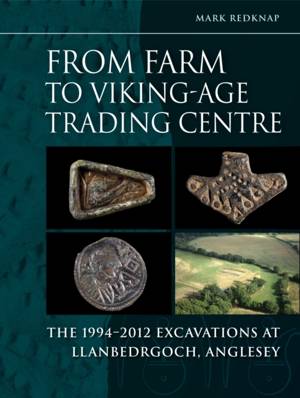
- Afhalen na 1 uur in een winkel met voorraad
- Gratis thuislevering in België vanaf € 30
- Ruim aanbod met 7 miljoen producten
- Afhalen na 1 uur in een winkel met voorraad
- Gratis thuislevering in België vanaf € 30
- Ruim aanbod met 7 miljoen producten
Zoeken
From Farm to Viking-Age Trading Centre
The 1994-2012 Excavations at Llanbedrgoch, Anglesey
Mark Redknap
Hardcover | Engels
€ 100,45
+ 200 punten
Omschrijving
The excavation at Glyn, Llanbedrgoch, revealed rich early medieval evidence, shedding light on Wales' 5th-11th century transformation.
The discovery of early medieval artefacts by metal detectorists at Glyn, Llanbedrgoch, Anglesey from the late 1980s led to a long-term programme of archaeological investigations by the National Museum of Wales (now Amgueddfa Cymru). Excavation revealed rich evidence for human activity from the Mesolithic period to the present, but its international recognition as a transformative site has been based on the remarkable early medieval evidence covering the 5th- to 6th-century transition up to the 11th century.
The early medieval enclosed settlement has produced the richest archaeological record in pre-Norman Wales for this period of political and cultural transformation. The site provides a unique sequence of development from small farm and entrepôt to a developing regional centre from the 7th century. By the 10th century, Llanbedrgoch had become an important commercial centre for the kingdom of Gwynedd, while possibly functioning in the manner of an estate centre with proto-urban potential. The excavated evidence shows an influx of material culture that is mixed, vibrant and in tune with the data from other sites around the Irish Sea and the Continent.
This publication integrates all the archaeological evidence discovered, including the first house plans from Viking-age Wales and details of objects made, cherished, consumed, destroyed and repaired. Eight early medieval burials provide data on personal appearance, health, diet and origins (including slavery), and four have facial reconstructions. New artefacts classifications and interpretations are provided, and corpora on dress accessories, hacksilver, household equipment and quernstones found in early medieval Wales presented. The social, economic and political contexts are discussed.
The discovery of early medieval artefacts by metal detectorists at Glyn, Llanbedrgoch, Anglesey from the late 1980s led to a long-term programme of archaeological investigations by the National Museum of Wales (now Amgueddfa Cymru). Excavation revealed rich evidence for human activity from the Mesolithic period to the present, but its international recognition as a transformative site has been based on the remarkable early medieval evidence covering the 5th- to 6th-century transition up to the 11th century.
The early medieval enclosed settlement has produced the richest archaeological record in pre-Norman Wales for this period of political and cultural transformation. The site provides a unique sequence of development from small farm and entrepôt to a developing regional centre from the 7th century. By the 10th century, Llanbedrgoch had become an important commercial centre for the kingdom of Gwynedd, while possibly functioning in the manner of an estate centre with proto-urban potential. The excavated evidence shows an influx of material culture that is mixed, vibrant and in tune with the data from other sites around the Irish Sea and the Continent.
This publication integrates all the archaeological evidence discovered, including the first house plans from Viking-age Wales and details of objects made, cherished, consumed, destroyed and repaired. Eight early medieval burials provide data on personal appearance, health, diet and origins (including slavery), and four have facial reconstructions. New artefacts classifications and interpretations are provided, and corpora on dress accessories, hacksilver, household equipment and quernstones found in early medieval Wales presented. The social, economic and political contexts are discussed.
Specificaties
Betrokkenen
- Auteur(s):
- Uitgeverij:
Inhoud
- Aantal bladzijden:
- 592
- Taal:
- Engels
Eigenschappen
- Productcode (EAN):
- 9798888571972
- Verschijningsdatum:
- 28/02/2026
- Uitvoering:
- Hardcover
- Formaat:
- Genaaid
- Afmetingen:
- 216 mm x 279 mm

Alleen bij Standaard Boekhandel
+ 200 punten op je klantenkaart van Standaard Boekhandel
Beoordelingen
We publiceren alleen reviews die voldoen aan de voorwaarden voor reviews. Bekijk onze voorwaarden voor reviews.








